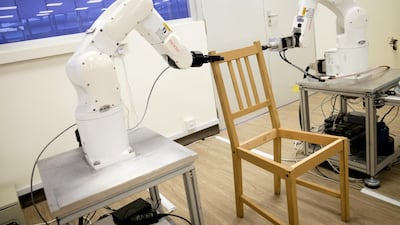Sick of struggling with incomprehensible instructions and a baffling array of planks and screws?
Help is at hand in the form of a new robot that can assemble an IKEA chair in minutes.
The robot, developed by scientists at Singapore's Nanyang Technological University, can put together the wooden IKEA chair in just eight minutes and 55 seconds - a swift timing that may give even DIY enthusiasts a run for their money.
The device, consisting of two mechanical arms with grippers, starts the process by taking photos of the parts spread on the floor with a 3D camera, which is supposed to mimic the cluttered environment after flat-pack furniture is unboxed.
Each arm has a similar range of motions to that of a human, while sensors mounted on the wrists monitor how much force is being exerted by mechanical fingers as it picks up tiny parts to expertly put the chair together,, according to AFP.
"For a robot, putting together an IKEA chair with such precision is more complex than it looks," said team leader Pham Quang Cuong, an assistant professor at the university.
"The job of assembly... has to be broken down into different steps, such as identifying where the different chair parts are, the force required to grip the parts, and making sure the robotic arms move without colliding into each other."
"We have achieved the low level capability to teach the robot 'how to do it' and then in the next five to 10 years, high level reasoning - the 'what to do' - could be done too," Mr Pham told Reuters.
He said the team at NTU were looking to work with artificial intelligence experts to try and hone the process.
_______________
Read more:
The legacy left behind by Ikea founder Ingvar Kamprad
To replace or repair an appliance, how can one decide?
_______________
Cindy Andersen, global business area manager of kitchen and dining at IKEA, told Britain's Daily Mail newspaper: "It's interesting to see an example of how robots could potentially contribute to our vision of creating a better everyday life for many people.
"We are very positive about embracing new technology."
Singapore has been pushing businesses to invest in automation and robotics to boost productivity as it keeps a tight leash on cheap foreign labour.
Some restaurants and hotels in the city-state use robots to deliver food to customers and collect used plates and cutlery.
The team is now looking into further developing the robot so it can learn to construct furniture by copying humans, reading an instruction manual or even just viewing a finished product, AFP said.
They are also working with the automotive and aircraft manufacturing industry where the robot could be used for such tasks as drilling holes in aircraft.
But those looking for help in assembling more household items from Swedish furniture giant IKEA may be disappointed -- for now the unnamed robot can only construct a humble chair.

